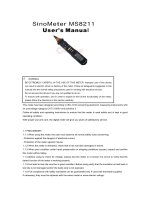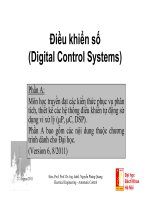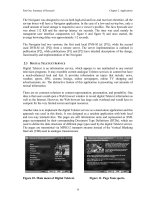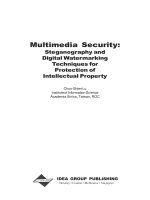Digital Television Techniques
Bạn đang xem bản rút gọn của tài liệu. Xem và tải ngay bản đầy đủ của tài liệu tại đây (787.57 KB, 31 trang )
1
2013 Digital televsion techniques – Lecture 1
453501 Digital television techniques (5 sp)
• Lectures
– Mondays 8.30-10, Thursdays 10-12, room B3039
• Exercises (5 exercises, 10 h)
– During lecture hours
– Electronic submission (on
• Exam
– May 24 2013., OR June 7 2013
• Books:
– Ulrich Reimers: Digital Video Broadcasting
– David Gómez-Barquero: Next Generation Mobile
Broadcasting (2013)
• Other material
– Lecture notes
– Specifications, articles, etc
2
2013 Digital televsion techniques – Lecture 1
Digital television techniques
Wireless communication technology
• Video broadcasting - historical overview
• MPEG-2 video compressing basics (exercise)
• Audio coding
• System / multiplexing
• Modulation and Digital modulation (exercise)
• •Forward error correcting techniques (FEC)
• COFDM-modulation technique (DVB-T/T2, WLAN)
• DVB standardization
• Simulation techniques
• Performance analysis
• SDR approaches
3
2013 Digital televsion techniques – Lecture 1
Digital television techniques
Introductional lecture:
* Television history
* Black and white television
* Color television
* Sound
* Progress towards digital television
4
2013 Digital televsion techniques – Lecture 1
Television history
1873 - Resistance of selenium bar changes in light
5
2013 Digital televsion techniques – Lecture 1
Basics for television
• Using fysiological capabilities of humans
– Eye will remember for a while
• 25 screen updates / s
– Eye/brain will combine dots to a picture
– Brain will combine a series of still pictures to a continuous
motion
– Color sensing capabilities
6
2013 Digital televsion techniques – Lecture 1
Television history – I Generation
1880 First articles appear in Scientific American
about the possibility of television.
1900 First known use of the word "television" at
1900 Paris Exhibition
1907 Boris Rosing (Russia) designs mechanical
scanner with CRT receiver
• On January 23, 1926, John Logie Baird (of
England) gave the world's first public
demonstration of a mechanical television
apparatus, license to transmit in London
• AT&T gives public mechanical television
demonstration (USA)
7
2013 Digital televsion techniques – Lecture 1
Nipkow's System
Nipkow's System
8
2013 Digital televsion techniques – Lecture 1
Electronical system
9
2013 Digital televsion techniques – Lecture 1
1928 Takayanagi gives demonstration of CRT
(Cathode Ray Tube) system in Japan
1935 ”First television broadcasting system in the
World” – Germany
1941The NTSC announced the recommended USA
standard of 525 lines and 30 fps (frames per
second).
1946 CBS gave the FCC a demonstration of their
mechanical color system
1953 Color TV broadcast begins
1954 RCA first all-electronic TV-set
1956 Time magazine calls color TV ”the most
resounding industrial flop of 1956”
Television history – II generation – B & W
10
2013 Digital televsion techniques – Lecture 1
11
2013 Digital televsion techniques – Lecture 1
Cathode Ray Tube
12
2013 Digital televsion techniques – Lecture 1
13
2013 Digital televsion techniques – Lecture 1
Television history
1972 Teletext experiments in UK
1974 First microprocessor used in Broadcast
1974 Betamax home VCR
1975 Work begin on a digital video standard
1986 Sony digital videotape recorder (D-1)
1990 All-digital HDTV is proposed
1995 First television delivered over the Internet
14
2013 Digital televsion techniques – Lecture 1
Basic black & white television
15
2013 Digital televsion techniques – Lecture 1
Video Casette Recorder
16
2013 Digital televsion techniques – Lecture 1
PAL ”M” –system (6 MHz / but comparable with 8 Mhz system)
17
2013 Digital televsion techniques – Lecture 1
Color television
18
2013 Digital televsion techniques – Lecture 1
Color television
19
2013 Digital televsion techniques – Lecture 1
Luminance – Intensity (3.2 Mhz of 6 MHz)
Color television - B&W compability
Y = 0.3 R + 0.59 G + 0.11 B
Chrominance – Color information (on 3.58 MHz carrier)
Q = 0.21 R + 0.52 G + 0.31 B
I = 0.6 R – 0.28 G - 0.32 B
Original Red-Green-Blue values RGB separated into:
20
2013 Digital televsion techniques – Lecture 1
Color television - B&W compability
21
2013 Digital televsion techniques – Lecture 1
Receiver block diagram
22
2013 Digital televsion techniques – Lecture 1
lines active vertical aspect horizontal frame rate
lines resolution ratio resolution
NTSC 525 484 242 4/3 427 29.94
PAL 625 575 290 4/3 425 25
SECAM 625 575 290 4/3 465 25
Analog TV systems
PAL – Phase Alternation Line rate (Main Europe , inc. Finland)
NTSC – National Television Systems Committee (USA & Canada)
SECAM – Sequential Coleur Avec Memoire (France, former Soviet)
23
2013 Digital televsion techniques – Lecture 1
History: Analog TV standards in the world
(old information: Finland and Sweden has switched off the analog services)
24
2013 Digital televsion techniques – Lecture 1
TV broadcasting
• Terrestial
– Roof top antenna
• Cable
– Modulated on normal channels
• Satellite
– Modulated on higher frequencies
25
2013 Digital televsion techniques – Lecture 1
1992 MPEG1 approved
1994 MPEG2 approved
1998 MPEG4/1 approved
1999 MPEG4/2 approved
2003 H.264/MPEG-4 AVC
2007 SVC Standard
2013 HEVC (h.265) standard
Television history – IV generation – digital TV
Content coding technology Broadcasting technology
1966 OFDM Patent (Chang)
1992 DVB organization founded
1994 DVB-C
1997 DVB-T
2004 DVB-H
2005 DVB-S2
2009 DVB-T2
2009 DVB-C2
2012 DVB-NGH









